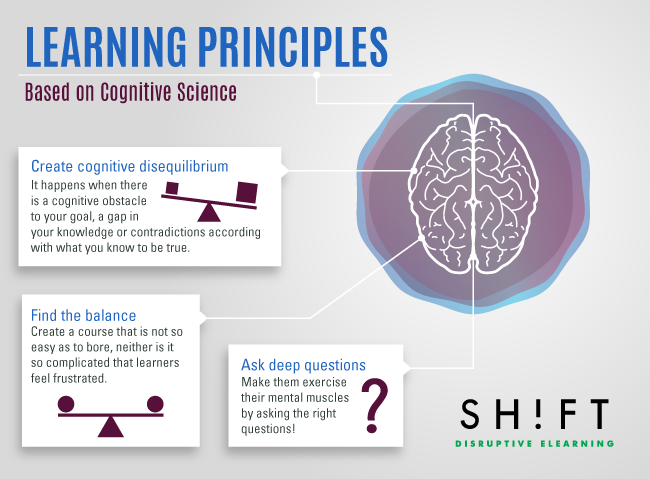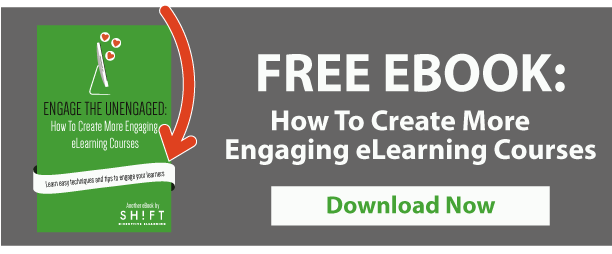Remember the school days? They were not only about making new friends, sharing lunches, having crushes, and dreaming of making it to the basketball team. There were some trying times too. For some, the Algebra class was a nightmare while for others, History lessons brought out the tears. Yet, the demons are not inside the formulae, dates, or maps. How a subject is taught has a lot to do with how well we learn it. Not every one of us had a passion for Literature, but we all loved it when Mrs. Smith made us dress up and play the characters from the stories we had to read. Not of all of us have grown up to become chemists, but many would love to go back to Mr. Henry's laboratory to once more have fun mixing chemicals.
The reason we see so many boring and passive eLearning is because it is just flat out easier for the designer. It is challenging to create learning that engages learners, that fires up their brain's synapses and makes content stick. But all you instructional designers out there, you have to take up this challenge; you owe this to your learners who have probably stayed back, rescheduled their meetings, or postponed tasks to take your course.
Lifelong Learning at Work and at Home generated 25 principles of learning and instructional
best practices, based on cognitive science. In this article we will focus only on three of these timeless principles; they will help you add ambiguity and create engaging eLearning.

1. The Goldilocks Principle
The keyword here is "balance." Goldilocks, of the fairytale fame who visited the house of the three bears, was happy only after she found the chair, the bed, and the porridge bowl that was "just right" for her—not too big or too small, not too hard or too soft, and not too hot or too cold.
You have to create a course that strikes just the right balance. It is not so easy that it insults the intelligence of the learners and drives them away with boredom. Neither is it so complicated that learners feel frustrated when they cannot crack the quizzes or make sense of the assessment activities. Your course has to tickle their gray cells and keep them interested till the end.
Your Takeaways
How can you make your course "just right" for your learners using the Goldilocks Principle? Before you head off for the drawing board, you MUST research into the prior knowledge and experience of the learners. Find out how much they know about what you are going to teach and what they expect to learn after taking your course. Step into the shoes of the learners, delve into their minds, and keep in mind the following pointers:
- Determine the learning outcomes such that they reflect the expectations and prior knowledge of the learners. But your course should strive to fulfill only a reasonable number of objectives so as not to overwhelm the learners and yet not leave them feeling cheated.
- Identify information that is absolutely critical to fulfill the learning outcomes. Do not cram your course with lots of nice-to-know information that won't help your learners when they go back to their workplaces. But if you provide only sparse information, your learners will feel they didn't obtain any value from the course.
- Create assessment activities that are neither too easy nor too hard. Don't make the answers obvious. But resist the temptation to create overtly complex activities where the solutions remain elusive; the learners may leave the course in a huff
2. Ask Deep Questions
What do you want your learners to do after they take your course? Just rattle off theories or actually be able to put them into practice? Do you want your audience to just learn how to operate a machine or should they also be able to troubleshoot the apparatus? Do you want your learners to memorize the names of all the U.S. presidents or should they also be able to compare the pros and cons of the policies the presidents implemented? Of course, you want learners to gain as comprehensive an understanding of the subject matter as possible. They should be able to think critically on their own, connect the dots, identify and explain patterns, and predict trends after gaining knowledge from your course.
However, the onus is on you to make them exercise their mental muscles by asking the right questions.
Your Takeaways
You can use scenarios woven within the course and assessment activities to ask deep questions to your learners. Here are some pointers:
- Ask open-ended questions that cannot be answered in one or two words but have to be analyzed and explained.
- Ask higher-order questions like "how," "why," and "what if" to make the learners reflect and ponder on their learning and apply it. The greater the level of mastery you want your learners to attain, the higher should be the order of the questions. Look to Bloom's Taxonomy to guide you to frame questions that demand different levels of understanding.
- Create interactive scenarios that let learners explore the consequences of their decisions and better assimilate the learning.
- You can introduce questions at any point of the course to engage learners. For instance, use questions right at the beginning of the course to encourage learners to explore their wants and discover the relevance of the learning matter themselves.
- Ask questions that are relevant to your learner's reality. It is not enough to whet their gray cells; they should also feel motivated to take up the challenge of your questions. Demand more from students and they will learn more.
3. Cognitive Disequilibrium
How do you motivate your learners to take your course? How do you keep them hooked to the course till the end? How do you ensure they find value in your course? You have to create a state of cognitive disequilibrium (Piaget, 1926) and then present your course as a tool that will help learners restore equilibrium. Huh!
In layman's terms, cognitive disequilibrium is that undesirable situation where you realize what you know won't land you the job (there is a cognitive obstacle to your goal), what you knew all along is actually wrong (there is a gap in your knowledge), or what you know to be true doesn't fit with what is real (there are contradictions or conflicts). Because we all abhor disequilibrium or a state of disharmony, we scramble to do what we can to restore equilibrium. When there is cognitive disequilibrium, the only way to restore harmony is to gather new knowledge to make sense. So the presence or realization of a state of cognitive disequilibrium acts as the motivation to learn.
Your Takeaways
You have to create a state of cognitive disequilibrium in your eLearning course to motivate learners. Here's how:
- Present challenging problems to compel learners to think critically. They will then look forward to your course for the answers.
- Expose gaps in the learners' knowledge using scenarios or by posing questions.
- Create scenarios or provide examples that contradict the learners' long-held beliefs. They will then be curious to know what more you have in store for them.
Recommended reads:
- Karl Kapp's article: Are You Challenging Your Learners? Don’t treat them like babies
- Training Zone's article: When challenging your learners backfires
- Cathy Moore's article: How to write challenging scenario questions
CONCLUSION:
The above-mentioned learning principles are based on psychological and cognitive researches. They provide valuable insights into the learner's mind and tells you how it grasps meaning and clings to it. When you apply these principles, you can create eLearning courses with enduring value.
REFERENCES:
Life Long Learning at Work and at Home. 25 Learning Principles to Guide Pedagogy and the Design of Learning Environments
https://activelearningps.files.wordpress.com/2014/07/25-learning-principles-to-guide-pedagogy.pdf



